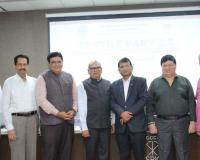Surat : Post-downturn, India's textile sector sees a resurgence in demand, affecting related industries.

Surat : The textile industry, the second largest employment provider after agriculture in India, is experiencing a resurgence. Since August, there has been a noticeable increase in activity within the industry, impacting various sectors including machinery, chemicals, and labor supply. This revival is particularly timely as the festive season approaches, driving demand for textiles and consequently, for weaving, knitting, embroidery, chemical treatments, and transportation services.
A surge in demand for clothes has led to an increased need for weaving and embroidery machines, dyes, and chemicals. As Diwali and the wedding season approach, the textile industry is expected to maintain this upward trajectory for the next few months. Despite a recent price increase of approximately 10 to 15 percent in raw materials, manufacturers have chosen not to pass these costs on to consumers, focusing instead on maintaining volume-based operations to recover from previous slowdowns.
However, the industry faces a significant challenge: a shortage of labor. Rajendra Upadhyay, head of the Tempo Delivery Contractors Association, reports that there is a shortage of about 15 to 20 percent in the labor force, particularly affecting mills and market deliveries. The labor shortage is exacerbated by the reduced migration of workers from states like Uttar Pradesh, Bihar, Jharkhand, Odisha, and Madhya Pradesh to Surat, a major textile hub. Many workers who do arrive are reluctant to engage in physically demanding tasks such as lifting heavy loads or working in the mills. This issue is expected to worsen around Diwali when many workers return home for the Chhath Puja, creating a crunch during a peak business period.
In response, the industry is adjusting by offering higher wages to attract and retain labor, although this is a temporary solution to a recurring problem. The festive season traditionally exacerbates the labor shortage, and this year's industry upswing means the impact will be more pronounced. The industry's stakeholders are urged to address these challenges proactively to sustain the growth and positive momentum.






